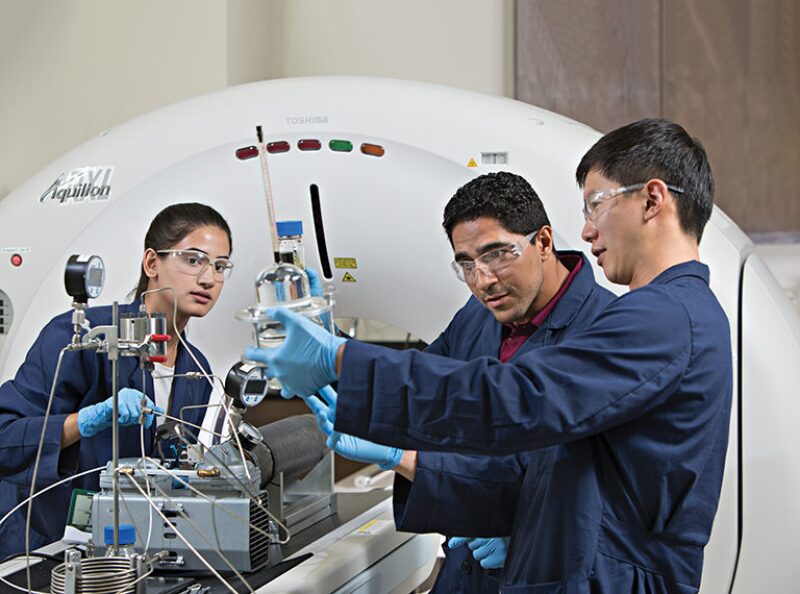When EOG Resources disclosed that it had found a way to get from 30 to 70% more oil from Eagle Ford shale wells, it set off a race among competitors looking for a low-cost way to add reserves by injecting natural gas.
It has been little noticed because few companies have said anything publicly about it. But university researchers and service companies are seeing widespread interest from companies that are trying to figure out how EOG uses gas injection to increase production and whether those gains can be sustained long enough to add reserves.
Research interest in gas injection enhanced oil recovery (EOR) persuaded David Schechter, a petroleum engineering professor at Texas A&M University, to equip his lab that has been used to test carbon dioxide (CO2) for EOR to safely observe how natural gas affects reservoir rock. “Basically everyone with a substantial acreage position is working on unconventional oil EOR now,” said Schechter.
“This is the name of the game. Everybody is talking about EOR and pumping money into trials of EOR,” said Deepak Devegowda, an associate engineering professor at the University of Oklahoma.
The question facing EOG and its competitors is, can they take a method that improves results from some of its best wells, and use it on a far larger scale to increase overall recoveries in unconventional formations where more than 90% of the resource is left behind.
Companies would like to understand and simulate it and, most importantly, they are looking for clues on how EOG did it. “A whole bunch of folks are watching what other people are doing,” Devegowda said.
Companies and researchers are using statistical analysis to determine patterns in production data filed with the Texas Railroad Commission to try to figure out how EOG is using natural gas injection.
Among those looking is Todd Hoffman, an associate professor from Montana State, who was initially skeptical of EOG’s claims. After studying the data, Hoffman said that EOG clearly is “seeing huge increases in added oil production.” He is now working on a paper based on the disclosures.
As for how he figured out which of EOG’s more than 7,000 Eagle Ford wells to study, he said, “I really had to dig around to find it. I talked to a number of companies planning pilots, doing pilots, in the planning stage, trying to do the same thing,” he said.
Competitors are also following the compressors. Another observer said competitors are tracking trucks moving the heavy equipment into work sites, and studying satellite images. The location and size of the heavy machinery offer clues as to where and how much EOG is injecting.
One of the few companies talking about testing is BHP Billiton, which is working with its partner Devon in the Eagle Ford.
“BHP has two enhanced oil recovery pilot projects operating in the Eagle Ford, one involving gas injections and the second involving the injection” of a chemical blend, Alex Archila, president of North American shale for BHP, said at the recent Unconventional Resources Technology Conference.
The partners are expecting to begin getting results in October. The company is looking at multiple approaches for different targets.
“I believe that miscible hydrocarbon gas injection, aqueous-based chemical injection, or a combination of these will provide uplift in the current depressed price environment,” said Matt Honarpour, a principal reservoir engineering advisor at BHP, adding that “there are challenges and high risk because of the complexity of these reservoirs.”
Marathon Oil has reportedly done a pilot project and plans to do more, according to other observers who have studied its work in production records. The company is also a member of a government-backed consortium working on enhancing production in North Dakota—the Bakken Production Optimization Program—along with seven other companies.
Core Laboratories recently started a gas injection EOR joint industry project in the Eagle Ford, said David Hume, vice president for Core’s reservoir division. The partners will share the cost and information from rock and fluid samples they provide. Its production enhancement division is also doing rock and fluid work and running tracers during injection tests for individual companies to see if injected gas treats the rock around the well and flows back, or shows up in nearby wells.
Mike Flecker, vice president of Core’s production enhancement division, would not name the companies working on it, but described them as innovative operators with the scale and expertise to take on the challenge. They need to be willing to invest in acquiring data and have an understanding of how gas EOR works at a time when there is not much science on which to draw. The available technical papers are based on lab testing data that are commonly used for simulations because field data are scarce.
The strongest evidence that the method does work is EOG’s growing testing program. At the time of the first announcement last May, the company said its 15 initial wells performed consistently, adding from 30 to 70% to reserves. It added 32 wells to the program last year, which produced an average of 80 B/D per well for an average finding cost of $6/bbl. It has not yet reported on this year’s 100-well program.
As for how it developed the technique, Billy Helms, exploration and production executive vice president for EOG, said that “results from lab experiments indicated that the process was technically feasible, but the economics and operational execution were going to be challenged without some creative problem solving.”
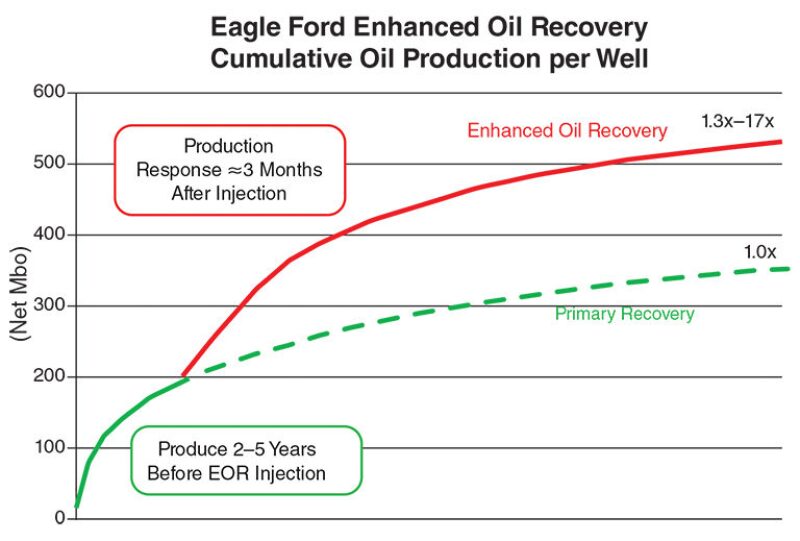
EOG on EOR
EOG is the first company to say it has significantly increased oil production from an unconventional play using gas injection.
Field tests since program started in 2013:
- The production increases on 15 wells indicated from 30 to 70% reserve gains.
- A 32-well test in 2016 added 300,000 bbl of oil at $6/bbl finding cost.
- Work is ongoing on 100 wells in six areas in 2017.
Inputs and Outputs
- Additional capital costs average about $1 million per well.
- The process uses associated gas from its wells.
- Production response is in 2–3 months.
- $1 invested adds $2 to net present value.
It Works if:
- The formation is able to contain high-pressure gas injection near the well.
- Wellbores contact the most productive rock.
- The completion maximizes the fractured area within a restricted zone around the wellbore.
Source: EOG.
Containment Limits
A broad look at gas injection EOR shows that it can work, but not always. It has been a hit in the Eagle Ford and a flop in the Bakken.
The difference appears to be containment. For gas injection to be effective, and affordable, the formation must allow the operator to pressure up the reservoir, keep the gas in there long enough to have an effect, and get it back for reuse or sale.
“The Eagle Ford formation allows some completions to be vertically contained, a unique feature that also plays a significant role in keeping the gas injection in contact with the targeted reservoir,” Helms said.
He said EOG’s results last year in the Eagle Ford gave the company “further confidence of the applicability of EOR across major areas of the field.”
But he warned that containment “may not exist in most horizontal oil plays.” That could include the Bakken, where EOG tried the method first and where those doing tests have been frustrated by their inability to contain the gas long enough for it to penetrate the reservoir’s dense matrix.
Based on lab results, natural gas injection should be able to extract more oil from Bakken rock. Small samples from various parts of the Middle Bakken were tested by the University of North Dakota’s Energy and Environmental Research Center (EERC). When exposed to natural gas or CO2, the chips produced more than 90% of the oil in the rock samples within 24 hours (SPE 184414).
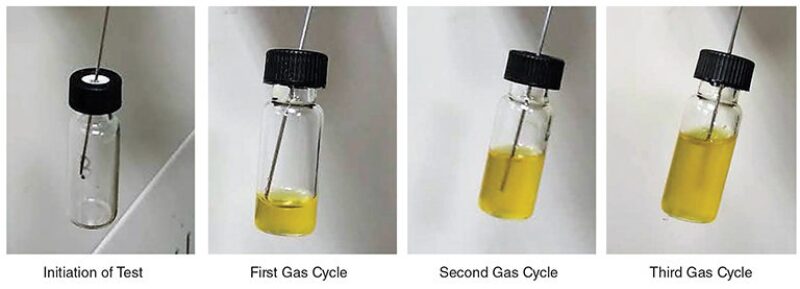
But in field tests, the “CO2 moves so quickly through fractures that it did not have enough time, or became too dispersed, to interact with stranded oil in the matrix” rock in the reservoir, James Sorensen, principal geologist for EERC, said in a recent EERC report to the US Department of Energy, which funded the project. As a result, “past pilot scale CO2 injection tests into horizontal, hydraulically fractured Bakken wells have shown little to no effect on oil mobilization,” he said.
When it comes to containment, beware of reservoir complexity. “The Eagle Ford is more uniform than the Bakken’s complex geology,” Hume said. The Permian Basin is the most heterogeneous of the three so generalizations are not useful.
The problems with gas-injection fractured Bakken wells are consistent with the lessons learned in conventional formations, where “one of the oldest rules is you never fracture the injector,” said Schechter.
The failed tests in the Bakken led the EERC and its partner XTO Energy, part of ExxonMobil, to try CO2 injection in the Bakken this year using an old vertical well that had pierced an unfractured spot in the Middle Bakken. After three periods of injection, lasting a total of 80 hours, and two shut-in periods giving the gas time to diffuse in the tight rock, there was a spurt of oil production, with 9 bbl produced over 45 minutes before it stopped.
Hoffman said the problems with gas injection into fractured wells got him thinking about using gas injection in an unfractured well, but soon realized that misses the point. “When we talked to partners they said there are tens of thousands of wells drilled and they need a solution for those wells,” Hoffman said.
The failure of conventional methods in the Bakken suggests to Sorenson that unconventional approaches are required. “The industry needs to think differently about these plays. Specifically, the mechanisms that control fluid movement within them, and recognize that each one is most likely going to require its own twist,” he said.
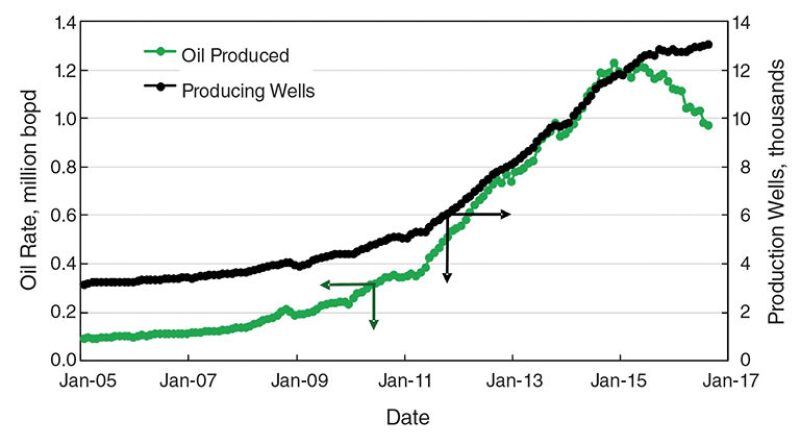
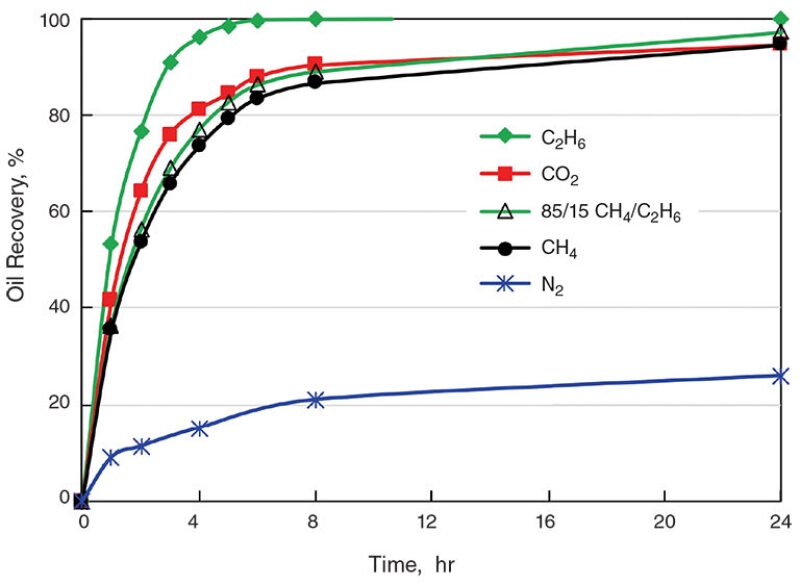
What Works
EOG has not disclosed how it uses EOR in the Eagle Ford. Others who have studied the up and down production patterns in disclosures say it looks like it is using a huff ‘n’ puff method. That is, gas is pumped into the well—the huff—and it is shut in for several weeks to diffuse into the tight rock around the fractures—and then it is opened up for production—the puff.
While huff ‘n’ puff has been around a long time, it is not widely used because no one wants to interrupt production. But at this point, soak time appears necessary in ultratight rock.
Schechter said the numbers he studied show the ups and downs of a huff ‘n’ puff well, with production starting low, a period with no production, and then a significant gain. He has studied the work of other researchers who have spent a lot of time trying to isolate single well performance in production disclosure reports commonly covering multiple wells.
EOG talks about rolling out its method in clusters of wells, some as close as 200 ft apart. “Now the 32-well pattern is probably a good indication of maybe what we will look at in the future,” Helms said during an investor briefing. Developing clusters of wells on pads would allow compressors to serve multiple wells. If injected gas migrates to a nearby well, it could be captured for reuse, cutting the gas cost and possibly aiding production.
The production added by gas injection appears directly related to how the well was fractured.
The wells that will work are those in which the initial fracturing job evenly stimulated the most productive rock along the wellbore, Flecker said. The many wells that do not meet that standard could be candidates for refracturing.
The surface area created by fracturing matters because the gas in the fractures does work deep into the rock, said Derek Beckett, director of technology development for Core Lab. He said the depth of the producing rock “may be an inch” or so.
“The key is really to get those developed with the drilling and the completions in the most optimal spacing and to connect as much rock through the primary process and that really enhances the EOR effectiveness,” said William Thomas, chairman and chief executive officer of EOG, during an investor briefing.
While EOG said it has successfully tried its method on wells that are as much as 5 years old, more often it is talking about adding production to relatively new wells using the latest methods for targeting the most productive rock and effectively fracturing it.
“Certainly, economically there might be an advantage to doing it earlier than later. But more importantly, the advanced completions are driving probably incrementally more success to start with,” Thomas said, adding that gas injection would likely be applied “in that first couple years.”
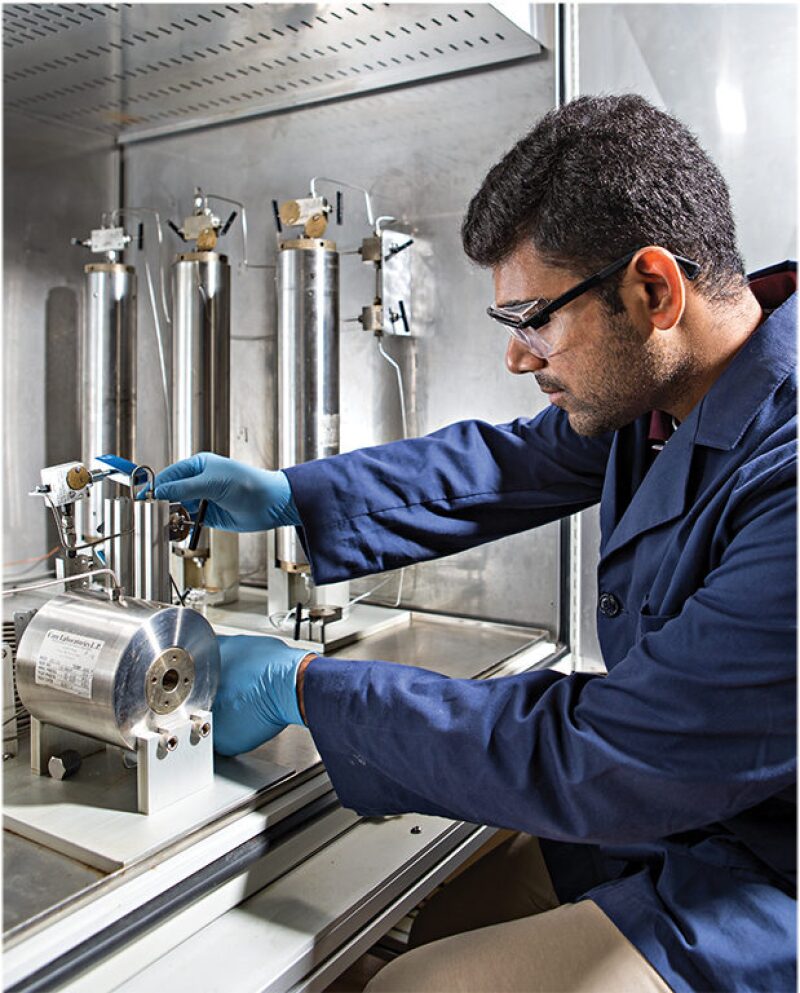
What’s Happening?
Early work on unconventional EOR quickly showed that widely used mental models—such as a waterflood pushing a bank of oil freed by a CO2—do not describe what is happening there.
“We are not pushing liquid through rock. We are engaging liquids with gas and producing it back out with the gas,” said Lawrence Bruno, president of petroleum services for Core Lab.
Engaging is an apt word for a process that draws liquids out rather than forcing them to move.
“It is the damnedest thing. I tried to inject it (gas) directly into cores. The pressure builds up and builds until” it reaches the limit of the equipment chamber, Schechter said. In contrast, he said when a shale sample is left to soak in a sealed vessel with gas or surfactant, eventually “oil starts dribbling out.”
There are long-accepted explanations for how the natural gas engages the liquids, and more are being offered as researchers look deep into pores so tiny they are studying new ways to image them.
The accepted benefits of injecting gas into oil reservoirs were described in a paper from the EERC (SPE 184414) as: reducing oil viscosity, swelling the oil volume, and vaporizing and extracting hydrocarbons from oil.
Beckett described how the interaction of oil and gas causes lighter molecules in the rock to become volatile. These lighter hydrocarbon molecules are stripped out of the oil by the injected gas, which is a solvent, and combine with the gas to create a hydrocarbon mist.
Those working on unconventional EOR are trying to understand why heavier hydrocarbons are left behind. “Frankly, we do not know why we are leaving behind stuff,” said Devegowda.
A better understanding may ultimately suggest ways of moving molecules small enough through the tight pathways in this rock, or how other molecules too big to make that trip are creating blockages.
For now they need accurate measures to simulate the process so they can figure out what is likely to work.
“One of the challenges that everybody has is forecasting performance,” Honarpour said. “Additional reliable laboratory data such as diffusion and vaporization in nanopore systems are needed. That takes effort to obtain.”
Diffusion and vaporization data are required to simulate the pace and effectiveness of the injected gas. Engineers need that to determine what is effective and when the value added by shutting in a well is more than the revenue lost by extending it.
Another elusive measure is the minimum miscibility pressure—the level at which the injected gas mixes freely with the oil allowing it to be most effective. The goal is to pump enough gas to reach that level without going much beyond, which can get costly.
“The calculation is straightforward, if you know the fluid composition. Unfortunately, we do not know it,” Devegowda, said. The problem is that “after 5 years of production you do not know what is in the ground.”
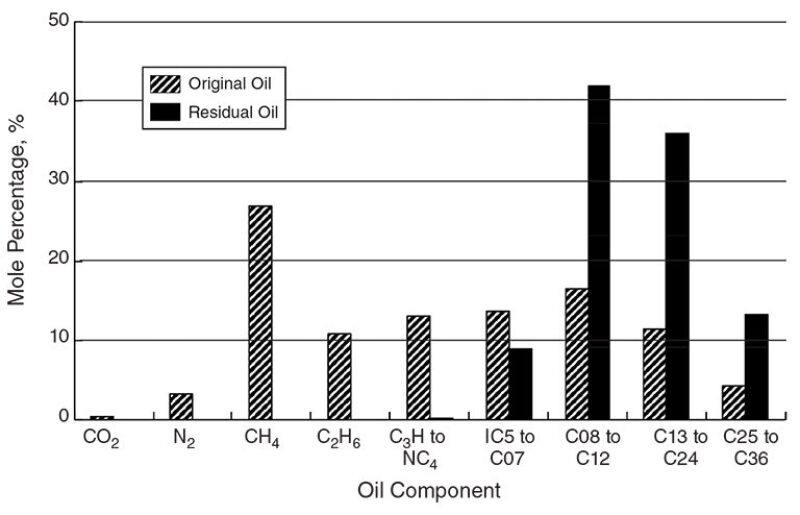
Other Theories
There are also unanswered questions about how long to produce before the next injection cycle, how many cycles are possible before the benefit wanes, and the volume of gas required.
“You got to go big or it will be a waste of time. Small gas injections will do little for you,” said Richard MacDonald, an engineering advisor for EP Energy. That advice is in line with conventional experience, but EP blazed its own path to it.
It developed a simulator with Schlumberger, which models how expanding gas expels oil within the nanoscale dimensions of the organic pores where oil and gas are created. It was used to predict how these pores would react if gas was injected in to recharge that drive, which is detailed in a recent technical paper (URTEC 2671283). It is now expanding that to simulate how gas injections will affect the total system.
That was a first step in a long-term project looking at how that process will affect liquid flow in the inorganic pores that provide storage and flow paths.
A recent study by the University of Oklahoma (URTEC 2668849) offered a novel explanation for the hydrocarbons left behind. The research investigated whether many pore openings are clogged when production begins and large hydrocarbon molecules, such as asphaltenes, try to move through pore throats a fraction of their size.
“Asphaltenes cannot flow through the pore throat but they can plug them quite effectively,” Devegowda said.
The paper measured this indirectly by comparing the pore surface area in rock samples as received by the University of Oklahoma laboratory, and then observed how much that area increased when these organic-rich shale samples were cleaned using a strong solvent.
A large difference was shown in the surface area after cleaning in the oil-rich shales. This suggests that injecting a solvent may open many pores that had been blocked.
There may be value in early EOR treatments “from day one” using solvents to try to open up those passages, and keep those obstructions from becoming permanent, Devegowda said.
Economic Imperative
Based on what EOG has said about its program, gas injection EOR can work. But will it be like conventional CO2 EOR, which works well in the few places it has been widely used, or something far bigger, further increasing the impact of shale on world oil markets?
“I am still optimistic, enthusiastic is too strong a word,” Hoffman said, adding, “It is such a big prize, eventually we will figure it out. There is so much oil at stake.”
A lot of the positive energy goes back to EOG’s success in the Eagle Ford. But shortly before EOG’s May 2016 announcement, Hoffman had delivered a paper (SPE 180270) on the frustrating results from the Bakken and was wondering if “maybe gas EOR is not the method we will use.”
Now he is more hopeful that an EOR method will be developed for the Bakken but “it may require a different solution.”
Dogged persistence will be required. “There are going to be a couple dozen failures before they figure out how to do it right,” Schechter said.
While an early failure can kill a new idea, the industry desperately needs a way to add lower-cost barrels and extend the life of unconventional wells to deliver a return on the huge investments being made to develop them.
It will take an awful lot of wells producing from 30 to 70% more to move the industry average rate for ultimate recoveries. Particularly since many will be at the low end of the range. “We believe that 30% uplift is closer to reality than 70% for lean gas injection in black oil or even in volatile oil,” Honarpour said.
Further Reading
SPE 180270 Improved Oil Recovery IOR Pilot Projects in the Bakken Formation by Todd Hoffman and John Evans, Montana Tech.
SPE 184414 Utilization of Produced Gas for Improved Oil Recovery and Reduced Emissions from the Bakken Formation by Lu Jin, Steve Hawthorne, and James Sorensen, Energy and Environmental Research Center, University of North Dakota.
URTEC 2671283 Dynamic Flow Behavior in Shales Described via Digital Rock Modeling Provides Insight into Gas Injection by Richard M. MacDonald and Steve Isaac Geetan, EP Energy; and Denis Klemin, Schlumberger.
URTEC 2668849 Impact of Solvent Extraction on Surface Area Measurements in Organic-Rich Shales Using Nitrogen Adsorption by Ankita Sinha, Son Dang, Carl Sondergeld, and Chandra Rai, University of Oklahoma.
SPE 185034 CO2 EOR Simulation in Unconventional Liquid Reservoirs: An Eagle Ford Case Study by Tuan Phi and David Schechter, Texas A&M University.

